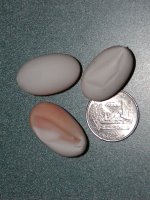
Not too long ago I rescued a Painted turtle that was fortunate enough to have crossed the road successfully. However, upon reaching the other side, she was unable to climb the new granite curbing that was recently installed. I was afraid that she would work her way back out into the roadway and fall victim to another passing vehicle, so I stopped.
I decided to take her home to show my daughter, as well as my niece, who was scheduled to visit at the end of July. We have one of those small plastic kiddies pools, which was immediately converted into a turtle pond.
She affectionately has become known as "Painty". Although she's in captivity and restricted to her new turtle pond, she eats better than most. I stopped at a local pond just the other day and was able to pull up a bunch of plants, i.e. duckweed, algae, lily pads and a few others I am not familiar with. These plants along with an occasional shrimp or two, as well as tuna fish have her doing just fine.
I realize and understanding why turtles typically risk their lives to cross roads. However, and perhaps selfishly, I kept her anyway. Sure enough we were not surprised to find that she laid 3 eggs. We gathered them up and just last night buried them as she would have. Although we choose to burry them in a very large flower pot filled with sand, which we intend to monitor and tend to in the hope of seeing and experiencing the birth of these tiny Chrysemys picta.
The picture above is of the three eggs she laid, and was taken with a US quarter to provide an example of just how small they are. Stay tuned to see how these little guys fair...I certainly hope we have better success with these eggs than we did with our chicken incubator eggs.
- - - - - - - - - - - - - - - - - - - - - - - - - - - -
From Wikipedia, the free encyclopedia
The Painted Turtle (Chrysemys picta) is a reptile that is common in North America, and is a water turtle related to other water turtles such as sliders and cooters. The turtle lives in ponds, lakes, marshes, and in slow-moving rivers that have soft, muddy bottoms.
In the wild, this turtle may live for over thirty years: in captivity it can live over twenty years. The painted turtle spends most of its time in the water but often lies on floating logs in the sun, as well as on rocks or by the shore.
During very cold weather painted turtles hibernate, burying themselves for months in the mud beneath streams and ponds. The mud acts as an insulator and helps to keep the turtle warm in harsh winter months. Painted turtles can survive long winters in ice-covered ponds because they can live for several months without breathing oxygen.
These turtles make great pets since they reproduce quickly and pose no threat of becoming extinct. The Painted Turtle is the only species in the genus Chrysemys. It is comprised of 4 sub-species.
Painted turtle eggs incubate an average of 10-11 weeks, but variation is considerable, depending on temperature.
Note: At incubations temperatures of 24-28 CELSIUS only males are produced. At an incubation temperature of 30C, 96 percent of hatchlings are female. Some other reptiles also have temperature-dependent gender of hatchlings.
3 comments:
Greets to the webmaster of this wonderful site! Keep up the good work. Thanks.
»
Thanks
Interesting site. Useful information. Bookmarked.
»
Post a Comment